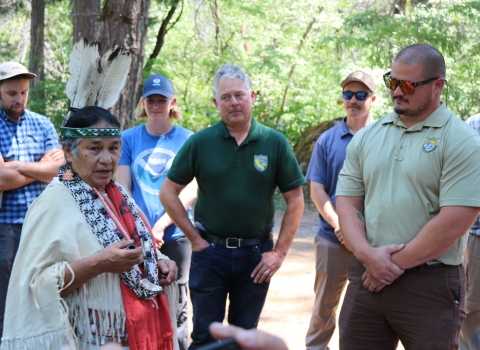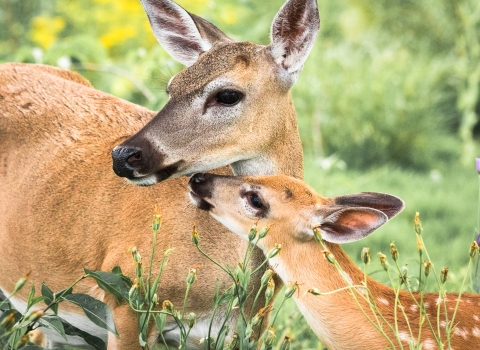Fire is a defining feature of the American landscape, responsible for creating, reshaping and regenerating our natural environment in nearly every corner of the Nation. But fire can also be a threat to life, property and wildlife, requiring careful monitoring, management, prevention and, when appropriate, suppression. Nowhere is this more evident than throughout the 568 units of the National Wildlife Refuge System, managed by the Department of the Interior’s U.S. Fish and Wildlife Service.
To ensure public lands under its care remain safe, productive and accessible, the Service uses the expertise of 312 fire management professionals. In 2019, these and other Service staff committed over 155,000 hours to wildland fire response and all-hazard risk management, treating 183,000 acres for hazardous fuels reduction through prescribed fire and mechanical treatments. Thanks to their heroic efforts, risks to people, property and habitat were minimized from the 348 wildfires that occurred this year on refuges. The leading cause of these fires was people.
“The dedicated men and women of the Fish and Wildlife Service work tirelessly to manage fire as a positive force on the land and to rapidly extinguish wildfires that threaten to destroy habitat and property,” said Margaret Everson, the Service’s Principal Deputy Director. “The Service continues to support firefighting activities on lands outside the Refuge System, even deploying overseas to help with catastrophic fires that threaten in-country resources. I am tremendously proud of the work we have done this year.”
America’s National Wildlife Refuge System spans every U.S. state, Puerto Rico and Guam, with a refuge within an hour’s drive of most metropolitan centers. Refuges provide unrivaled habitats that support the nation’s wildlife heritage and provide places for all Americans to hunt, fish, birdwatch, hike and enjoy. Refuge managers use fire as a tool in their management toolbox but must also contend with rising wildfire threats in many parts of the nation as a result of environmental conditions, such as ongoing drought. Over 80% of the Service’s fire efforts are strategically directed to the wildland-urban interface to ensure community protection.
Although 2019 was a below average wildfire year for refuges in the lower 48 states, with 268 fires burning just over 90,000 acres, Alaska suffered a worse than average year with 80 refuge wildfires that burned almost 595,000 acres. The biggest fire the Service had to cope with was the Swan Lake Fire on Kenai National Wildlife Refuge in Alaska, which burned on over 167,000 acres. Multiple fire teams managed this fire for more than 100 days.
In the years leading up to 2019, Kenai staff strategically applied 28 fuel treatments including forest thinning, pile burning and grinding woody vegetation with machinery (a process called forest mastication). This work is laborious, but helped reduce fire impact to critical infrastructure and communities on the Kenai Peninsula.
The Service also moves quickly after extinguishing wildfires to stabilize, restore and enhance burned areas and further protect waters, roads and communities from erosion and sedimentation. This year, the Service seeded more than 600 acres to keep soil in place. Through burned area rehabilitation, a long-term action to repair wildfire-caused damages, Service crews began restoring over 450 upland acres and 750 riparian riparian
Definition of riparian habitat or riparian areas.
Learn more about riparian acres. They also combated invasive species invasive species
An invasive species is any plant or animal that has spread or been introduced into a new area where they are, or could, cause harm to the environment, economy, or human, animal, or plant health. Their unwelcome presence can destroy ecosystems and cost millions of dollars.
Learn more about invasive species encroachment on nearly 1,200 acres and repaired 16 miles of refuge fencing.
“The Service is proud to work with our federal, state, tribal and local fire management partners to provide superior service to protect and enhance our nation’s natural resource treasures and to stand side-by-side protecting our communities,” said Everson.
A key fire-management partner is the U.S. military. Through prescribed fire or mechanical forest fuel reduction, the Service provided mission support to 14 U.S. Air Force installations across the country in 2019 to reduce the potential for lost training days and damaged infrastructure. These actions not only support our nation’s military readiness, but also further our conservation mission on military lands.
The Service continues to support ongoing efforts to combat the catastrophic wildfires in Australia. Since December, seven Service firefighters have deployed along with more than 140 from other Department of the Interior bureaus and the U.S. Forest Service at the request of the Australian Fire and Emergency Service Authorities Council.
“The loss of life, property and environment are devastating in Australia,” said U.S. Secretary David Bernhardt. “The United States stands with our partners, and we will continue to support Australia in sending our world class personnel to contain these blazes and help protect Australian communities and wildlife.”
The United States, Australia and New Zealand have been exchanging fire assistance for more than 15 years and Australian and New Zealand personnel filled critical needs during peak U.S. wildfire season.
For more information on the fire management at the Service, visit https://www.fws.gov/fire/. For more on the Department of the Interior’s Office of Wildlife Fire and its coordinated efforts across Interior bureaus to manage and control wildfires, visit https://www.doi.gov/wildlandfire.



